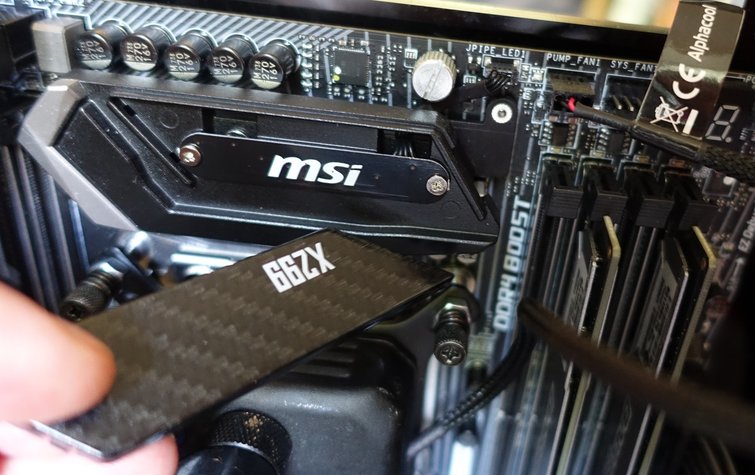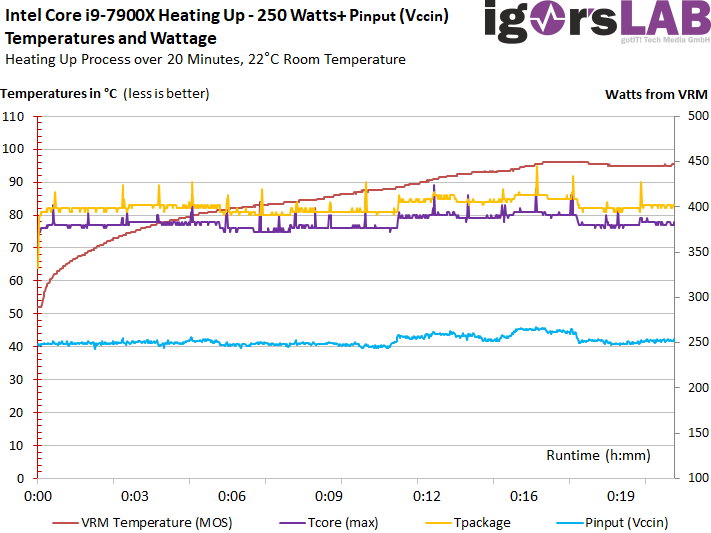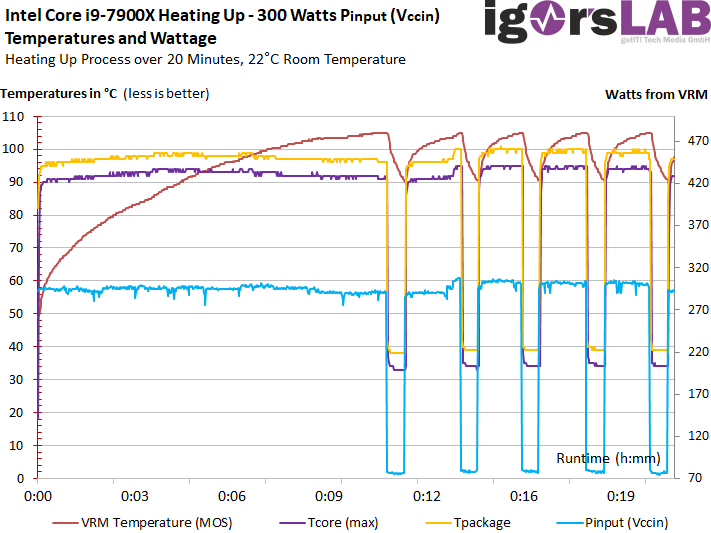We take the mainboard manufacturers to task as well
To only blame Intel and the CPU clocked to its pain threshold ex-works for a looming heat inferno would certainly be too short-sighted in total. Especially when you consider the consequences of the performance madness for the other components, such as CPU coolers and voltage converters. Unfortunately, the hype train always makes users expect true miracles from the overclocking scope of an Intel CPU, and it is also the PR machine’s fault to fuel the engine even further.
We have already reached the performance ranges of current high-end graphics cards and above with the Skylake-K – AMD’s FX-9590X is downright an abstainer in direct comparison. Manufacturers and financial departments alike will have to grit their teeth and spend a few more dollars on voltage converter coolers and better components, profit optimization or not. It’s all about the customer and long-term reliability. Ultra-durable military class is also possible in Solid Rockstable, but without extensive plastic orgies and LED light chains – if you want to.

The motherboard manufacturers should not only have been able to anticipate the electrical binge despite Intel’s silly low stated TDP, but they should have known better. After all, the specs are available to everyone, not just us. Of course, this affects the boards to a very different degree and extent, but the example we tested isn’t the highest in the company’s internal food chain either. However, you can’t generalize it and certainly not speak of a VRM disaster if you haven’t comprehensively tested all price ranges of the most important manufacturers. The problem is, as always, under the CPU cooler and sometimes also in the financial departments of some manufacturers.
We have already ordered a “higher-quality ” board from the same manufacturer and will re-test the marginal value experiences in a follow-up. But how the whole thing turns out for today and what lessons should be learned, we see now.
Watts instead of GHz – we are now sounding out limit values
We thought for a long time about how we could use the remaining overclocking margin, because in the end it was primarily about the cooling problems of CPU and voltage converters in general and not about snapshots of a CPU assigned in the CPU lottery or the skill of an editor in detail. Therefore, we systematically pushed the Core i7-7900X further to 250 and later 300 watts. More is not allowed according to the specs and so we leave it at that.
Leaflet #6
We would like to remind you of the media’s responsibility at this point, because we can’t and don’t want to give instructions for the potential destruction of hardware. This is something everyone has to work out for themselves, because in contrast to the commercial overclocker upper class, who rarely have to worry about CPUs, the end customers and we only have one CPU and therefore only one attempt. Much of what looks so playfully simple on the Internet can quickly end in personal and financial fiasco. Specifications and limits are there to be followed. Period.
Let’s start with the 250 watt limit, which we also reached earlier with a Core i7-5960X at 4.8 GHz clock. The Core i7-7900X still manages 4.5 GHz with Prime95 and 4.6 GHz with Luxrender in the console loop with this power. Other applications snatch correspondingly less, whereby the Core i9-7820X is hardly more frugal. It is only separated by a whole 20 watts from the big ten-core in the same scenario. Thus, if you want to overclock, you should pay attention to the wattage and adjust the clock and voltages with try & error – depending on the desired applications.
250 watts and the limits of a normal water cooling system
In the scenario, we also reach the 270 watt mark, which we would mark as the upper limit for this motherboard. MSI’s X299 Gaming Pro Carbon AC is thus still about 30 watts below what Intel allows in the specifications. But: it is hardly possible to cool the package and cores without a chiller and instead with a normal, good custom-loop water cooling, so that thermal downclocking does not occur beforehand. With tested 30°C for the water temperature, it is already no longer possible to work consistently without limitations for longer than 10 to 15 minutes!

Before the VRM on the board reaches the 100 degree mark, the CPU already limits. From this point of view, the plastic including the bling-bling on our VRM cooler is almost inconsequential, because you can’t reach these areas unheaded anyway. Of course, we have a suitable video for the diagram here as well
Intel’s limit: 300 watts and a mild whiff of disaster
Alright, let’s get factual again and better see about escaping heat death once more. Can the chiller-cooled CPU and the motherboard VRM break the 300 watt mark unscathed? To cut a long story short: it even works for 10 minutes. But then it’s also over here and the voltage converters reach the 105°C mark. Now the CPU shuts down to 1.2 GHz and the power consumption is throttled to 70 watts. That is enough to recover quite quickly and fall into an endless loop.
It was not quite enough, but seriously: Who would connect a chiller to such a CPU in everyday use? No normal user will ever be able to have this near-death experience unless they have a decapitated CPU. Even with the chiller, Tpackage scratches at the 100 degree barrier and even cracks it. The cores are happy about a cozy 94°C . Thus, there is nothing left in the overall artwork that can be considered sufficiently cooled.

The matching video once again shows the motherboard and the heated areas. Despite partially reaching 105°C, no components are in danger whose permissible temperature window would be lower. So, at least something.
This reduces the circle of those who get this far at all to a tiny minimum of potential users. Those among them who professionally specialize in torturing or testing silicon products shouldn’t have a hard time asking the relevant motherboard manufacturers for a more appropriate motherboard for such games.
The end customer, who has already spent a lot of money on a pre-headed CPU or his own thrill, won’t feel the 50 to 100 euro surcharge as a real pain then. The vast majority, however, will only encounter this disaster, if you can even call it that, on YouTube & Co. due to the lack of their own cooling. Then it still has a certain entertainment value, but it almost never affects you personally.
Summary and conclusion
What can we summarize? On the one hand, Intel has once again brought out the baton and ennobled a Xeon with a lot of clock to a HEDT behemoth. On the other hand, this action should also make it more than clear that the core architecture has reached its end. It still works quite well and if Intel hadn’t been afraid of its own courage in the end and put a thermal brake block between Die and IHS, there could have been a happy ending for all involved.
But as it is, even with normal custom-loop watercooling, you’ve reached the upper end of the coolability scale at values up to about 250 watts, before most motherboard voltage converters could have even said goodbye. Throttling always happens first in the CPU and not on the motherboard under normal circumstances. This circumstance, in turn, nonchalantly takes the top off any perceived sensation.
Nevertheless, the motherboard manufacturers naturally also have a certain share of the blame for the big media wave, which is currently sloshing back and forth. Because with a bit more thermodynamic expertise, a bit less plastic baroque in the finish and dimmed LED RGB Christmas tree illumination, the motherboards could have cut a much more solid figure for the same price. Thus, all speculations would have been superfluous from the start. Owning things that are tightly sewn to the edge always has a certain aftertaste, because no one knows what reserves they might need after all.































1 Antwort
Kommentar
Lade neue Kommentare
Urgestein
Alle Kommentare lesen unter igor´sLAB Community →